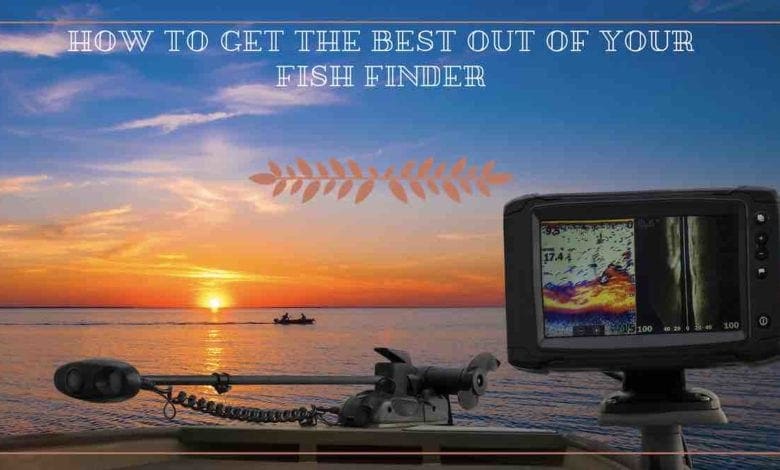How to get the best out of your fish finder

Nowadays, everyone from weekend recreational fishermen to professional bass anglers spend over $1,000 on electronics for their boats. The number of fish finding units reading the Down Scan, Side Scan, and the Sonar on these boats can confuse even the most experienced anglers. In fact, a huge percentage of these fishermen don’t know how to differentiate between clutter and a fish or a soft and a hard bottom on their screens.
All fish finders come with factory-set filters that are meant to help you detect a school of fish. Therefore you should know which factory-set filter to use or learn how to set up your fishfinder to pick up the right signals. Besides having a good fish finder for the money, you must also know how to decipher the images on your screen. So here are some essential tips to help you get the most out of your fishfinder.
Consider the Weather
The probability of catching more fish will depend on current weather conditions. Anglers catch more fish during the warm days than the cold ones. That is because fishes are more active during sunny days than the cold ones. Fish usually leave their usual spots and assemble near a water bed or deep near the base of the lake, making it easier for your equipment to detect a school of fish. Plus, it’s easier to lure them with your bait in warm weather conditions than during a cold rainy day.

Find out How to Tune Your Fish Finder’s Sensitivity
It’s crucial to note that one set of your equipment’s sensitivity can detect and catch a fish. However, switching off the automatic mode of your device can amplify its sensitivity. The sensitivity setting determines the amount of data you will be reading on your screen. Start by tuning it down until the only thing on your device is the bottom reading. You can then start tuning it up slowly until it reaches a level you are comfortable with. At maximum sensitivity, your sonar can give you precise information about everything below your boat.
Keep Things Simple
All fish finders are ready to go right out of the store. In fact, these devices come with the most efficient technologies that can help anyone catch a fish. However, most professional anglers love to keep everything as simple as possible. Instead of using the factory set filters, they learn how to adjust the fish finder. These factory-set filters do a lot of guessing, and they can be easily fooled by false-signals. So learning how to set up your fish finder can result in you being more efficient and knowledgeable when looking at your screen.
One of the most crucial things you need to understand about the graphs on your screen is that there is no perfect setting for your electronics. In fact, there are several right and wrong methods of setting them up. So, you need to find a setting that works perfectly for you and stick with it. Once your equipment is set up, you can study how the graph behaves when your sonar comes into contact with different structures. This way, you will know if you can catch a fish or not by looking at the images on your screens.
Recognize School Formations
Anglers have several details that they must decipher every time they go fishing. Therefore, you should learn how to identify and differentiate between schools of fishes by just studying the graphs on your screen. Other than discerning schools of fish, most experienced anglers can differentiate between fish species using these electronics. They can even tell you if it’s possible to catch the fish or not. So here are the three school formations you can look out for when fishing with your electronics.
Attack Formation
This school formation is when the school of fish is in a tight vertical formation on your screen. With this school formation, you can throw any lure into the water and catch a fish. The fish are usually grouped in a haystack or mound formation somewhere within your sonar’s range. If there is a hump or ledge in the region, these fish won’t be swimming all over the structure. Instead, they will be found about 5 ft above the bottom of the lake. Tom Redington, a professional angler, refers to this formation as an attack formation.
Wall-To-Wall Carpet
Here the fishes are not in a group; instead, they are spread out evenly at the bottom; Redington refers to this formation as wall-to-wall carpet. He suggests that on a slow day, you can drop your bottom bait and hope to catch some stragglers or leave the and check on the school later.
Explosion
Although an explosion of fish on your screen can be enticing, Redington believes differently. During this situation, the baitfish and the fishes are usually spread out in different directions. So when you find a school like this one, it’s best to move on and maybe check on them later to see if they have grouped up. Most beginners waste most of their time in a school like this one, but it is almost impossible to catch a fish in this formation.
Zoning In
One of the best ways to find bass in an offshore structure is to move around the object in a zig-zag manner. Once the fish finder detects a school of fish, you can cast your bait and confirm your suspicion. .As soon as you are sure that there is a school in a certain region, you can start narrowing your search. Bass tends to inhabit the same depth throughout the river or lake.
Therefore, once you have determined the right depth, you can look at your map and spot as many structures as possible in that region. If you find them around a sloping point in about 17ft of water, you can look for more points and scan them using your fishfinder. This technique will help you zone in on some of the lake’s productive spots and save you a lot of time.
Final Thoughts
Fishing is more than just having the right fish finder and the best fishing gear in the market. Any experienced angler can tell you that identifying the right school formation is essential. So you should first find the structure using your fish finder before you start fishing
